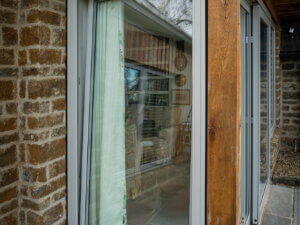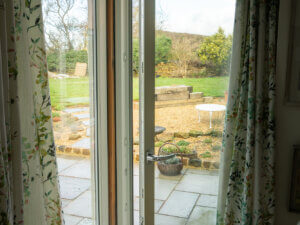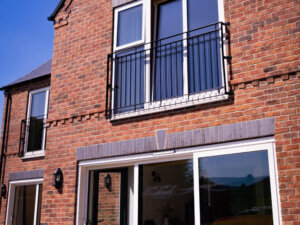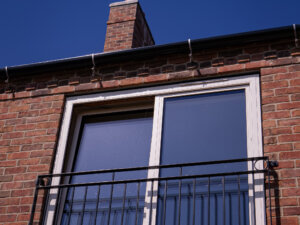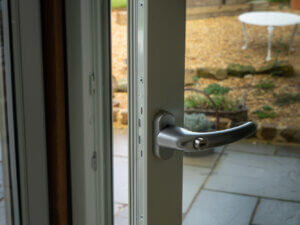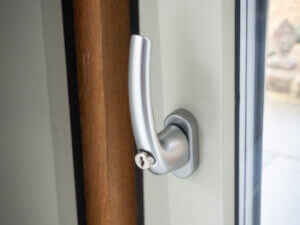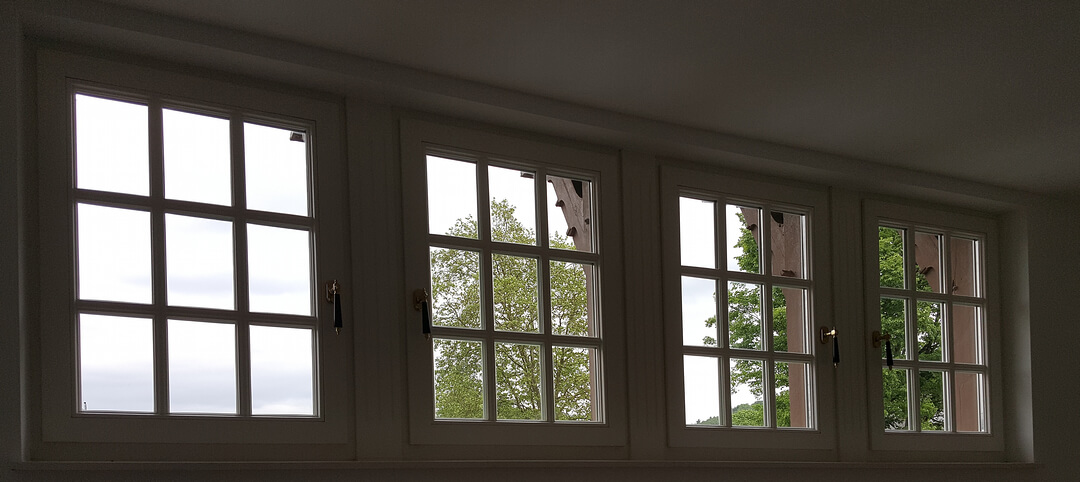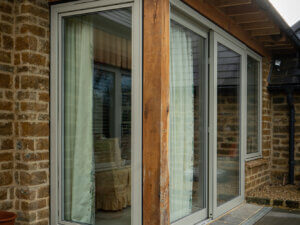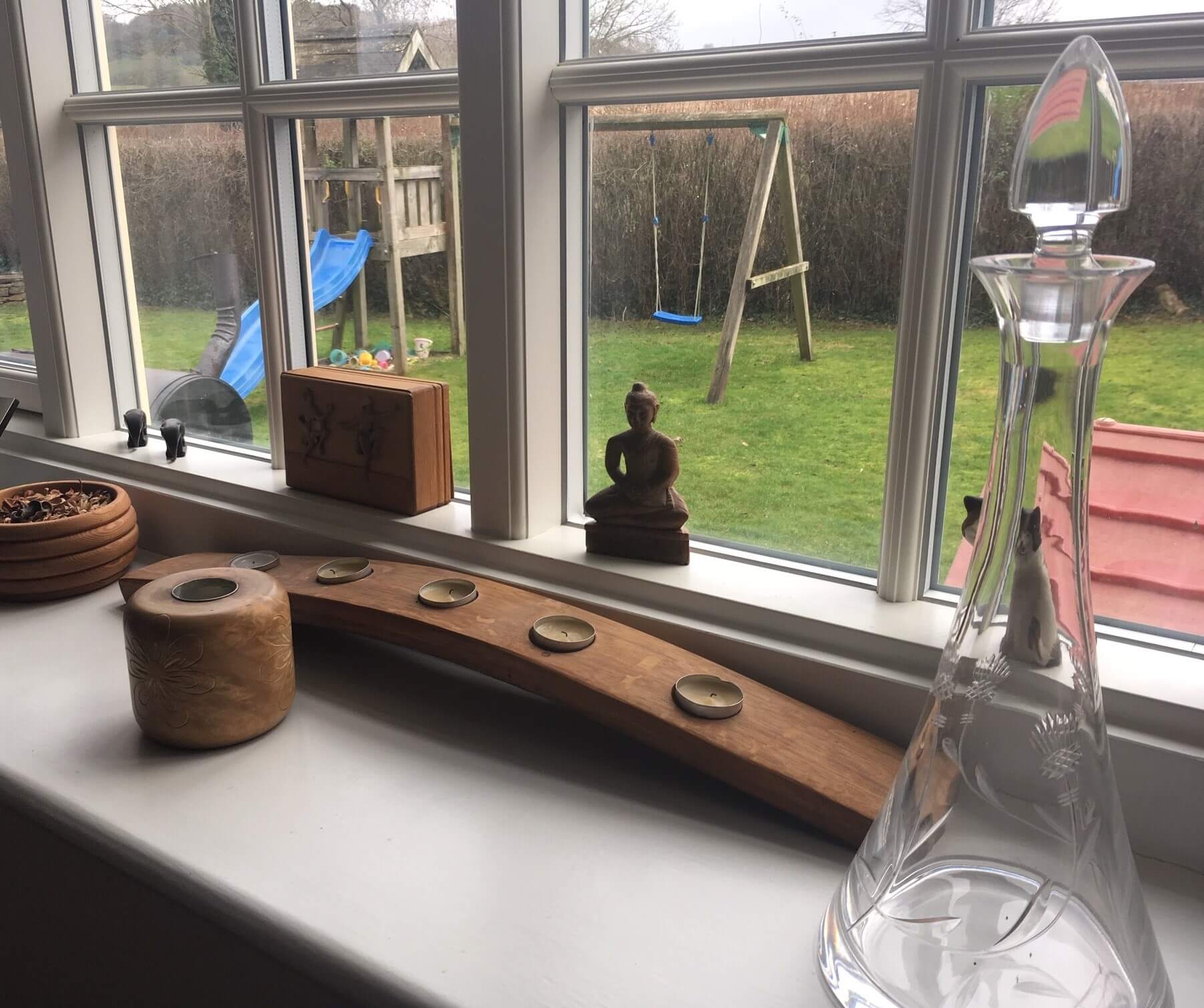Tilt & Turn Windows
Quite rare in the UK, tilt turn windows are ubiquitous in Germany due to their bonuses over an average UK window. The design of the tilt and turn mechanism allows for both the most efficient, secure ventilation (directing air upwards in the room) and still provides a means of fire escape. Rain is also less likely to get into the building in the tilt position as the water is directed down the window into designed drainage channels.
What is a Tilt Turn Window?
A tilt and turn window opens on two axes: tilting when ventilation is needed, and turning for purge ventilation or when fire egress is needed.
In the ’tilt’ position, the window tilts inwards into the room, remaining fixed at the base. This allows ventilation, whilst still maintaining a high level of security and shielding off the rain. Our heavy-duty window opening mechanisms provide security even when open.
Some Benefits of a Tilt and Turn Window
- The outside of the glass is very easy to clean from inside
- Being able to open the same window different ways is incredibly flexible and practical
- It is possible to have a tilt before turn mechanism and a key lockable handle which allows the window to open in tilt position but avoids the risk of children accidentally opening and falling out of windows
- Tilt and turn provides excellent fire escapes as the windows can open fully in the turn position. This is unlike top hung or friction hinge windows – so commonly seen in the UK.
- Security is excellent, even when open in the tilt position, and almost impenetrable when closed thanks to the multi-point locking system.
- Tilt and turn also allow significant engineering space to fit multiple seals necessary to achieve the best possible airtightness rating. Beware of slim frames. They are unlikely to provide superior air and water tightness (but might be attractive in design).
- Frames can be installed in a check reveal up to external building finishes – this maximises light
- Design features such as Georgian bars, flying mullions and robust mechanisms ensure large expanses of glass are very feasible. If it can be done in an open out conventional casement, it can be done in tilt and turn too.
Tilt and Turn, or Tilt Before Turn?
These are actually two different mechanisms. If you’re used to one of them, it will be a little annoying to suddenly switch the other – it would be like suddenly swapping the hot and cold taps…
- A traditional (and majority of modern) German tilt-turn window works as follows:
- When closed, the handle is pointing down
- If the handle is turned 90 degrees from closed, the window will turn 90 degrees on it’s side hinge
- If the handle is turned 180 degrees from closed, the window will tilt inwards, pivoting on the bottom hinge, creating a ventilation gap at the top
- But the less common Tilt Before Turn window is the opposite:
- When closed, the handle is pointing down
- If the handle is turned 90 degrees from closed, the window will tilt inwards, pivoting on the bottom hinge, creating a ventilation gap at the top
- If the handle is turned 180 degrees from closed, the window will turn 90 degrees on it’s side hinge
In both cases, as the windows tilts inward, they can be used to ventilate a space in bad weather and be opened with lesser risk of a break-in. The tilt function usually opens by just 5-10cm, meaning that there is not enough room for someone to climb or reach through. When in its turn position, this allows the window to be cleaned from the inside of the building and allows for an escape route in the event of a fire.
A further aspect to the security of leaving a tilted window open is that you must close the window fully to change the position of the handle. Since it’s not possible to move the handle from the tilt position into the turn position from outside, it’s not easy for someone to open a tilted window any further.
The version that you choose should be entirely your preference. Most of our customers who ask for this style of window have become accustomed to the idea whilst living in Germany or mainland Europe in general, so it makes sense to provide them with the option they are used to.
But, sometimes, tilt-before-turn introduces a more practical solution. Firstly, these windows are intended to be tilted for the majority of times you’d want to open them, so reaching that part of the mechanism first is fairly logical. Further to that, having the tilt position before the fully-open turn position creates the opportunity of locking-off the larger opening. Handles can be restricted to only being allowed to turn 90 degrees, giving an extra amount of security and child safety (if this handle were used on a traditional tilt-and-turn window, you would lock-off the tilt function…perhaps not so helpful…)
Technical Benefits of a Tilt-Turn Window
- Better airtightness, due to both the locking points and the rubber seal which runs around the whole perimeter of the window, thus pulling the window sash tightly into the window frame.
- Lower thermal gradient in the window frame. A tilt and turn window can have up to four airtight seals across the frame. Most normal UK windows have just one. Don’t be confused by flap seals around the external perimeter of the outer frame, which have cut-outs for drainage. This is just a weather seal that allows cold air to enter into the gap between the opening sash and the window.
As a result, the distance between the outside air at zero degrees and the inside air at 20 degrees is only the width of the airtight seal. As most tilt and turn windows have 2-3 seals, the inner chamber behind the first airtight seal is often at 12 or even at 15 degrees, meaning that the thermal gradient is gentle. The frame is thus warmer and the window offers better performance
A Brief FAQ Section!
- No, tilt and turn windows cannot (and should not) open outwards. Whilst it would be physically possible to manufacture, it’s honestly not very sensible: having a window tilting outwards with the hinge at the bottom is fine until it rains… Since it rains quite a lot in northern Europe, this idea isn’t offered and it actively discouraged by the vast majority of manufacturers.
- It can be awkward if you like to have items placed on your internal window cills. However, since most people will be tilting windows open – this movement doesn’t disrupt items on the window cill. It’s only when the window is fully turned open (for cleaning, or in an emergency) that this becomes an extra task.
- Tilt-turn windows may not comply with UK building regulations, although, obviously, ours do. Part Q for security is a common elephant trap because it references the UK-specific PAS24 test. It is wise to seek assistance from UK companies about this, who have UK-based staff and UK aftersales. Companies familiar with the problems will be able to guide you through how to check whether a product’s European equivalent test will be suitable for use.



